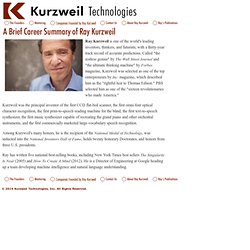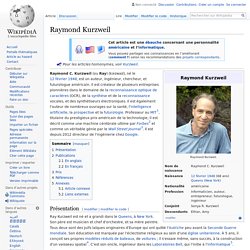

About Ray Kurzweil. Ray Kurzweil is one of the world's leading inventors, thinkers, and futurists, with a thirty-year track record of accurate predictions.

Called "the restless genius" by The Wall Street Journal and "the ultimate thinking machine" by Forbes magazine, Kurzweil was selected as one of the top entrepreneurs by Inc. magazine, which described him as the "rightful heir to Thomas Edison. " PBS selected him as one of the "sixteen revolutionaries who made America. " Kurzweil was the principal inventor of the first CCD flat-bed scanner, the first omni-font optical character recognition, the first print-to-speech reading machine for the blind, the first text-to-speech synthesizer, the first music synthesizer capable of recreating the grand piano and other orchestral instruments, and the first commercially marketed large-vocabulary speech recognition.
Ray has written five national best-selling books, including New York Times best sellers The Singularity Is Near (2005) and How To Create A Mind (2012). Surging Solar in 2011 Proof of Ray Kurzweil’s Bold Prediction? Is a solar powered future closer than we think?

A recent report by British Petroleum (BP) found solar power generating capacity surged 73.3% last year. If you’re a dedicated fan of the singularity, statistics like that are reminiscent of Ray Kurzweil’s solar dictum—that solar power is on an exponential path, doubling every two years. To what end? A cheap, clean, and virtually boundless power source for humankind in two decades. Nothing major. The report has some sunny stats for solar enthusiasts.
That’s pretty positive news. Credit: 2012 British Petroleum Statistical Review of World Energy. After we’ve solved the energy puzzle, we can move on to other intractable issues, like insufficient food and water. But let’s temper our enthusiam for a moment. Raymond Kurzweil. Un article de Wikipédia, l'encyclopédie libre.

Pour les articles homonymes, voir Kurzweil. Raymond Kurzweil. Présentation[modifier | modifier le code] Ray Kurzweil est né et a grandi dans le Queens, à New York. Son père est musicien et chef d'orchestre, et sa mère peintre. À 15 ans, il met au point un logiciel de reconnaissance de thèmes musicaux analysant les œuvres de compositeurs classiques, puis synthétisant ses propres chansons en imitant leurs styles. Kurzweil fut le développeur principal du premier OCR reconnaissant toutes les polices, du premier relecteur d'écran pour les non-voyants, du premier instrument électronique capable de recréer le son d'un piano à queue et d'autres instruments d'orchestre ainsi que d'un système de reconnaissance vocale.
Il est notamment président fondateur de la Fondation Kurzweil, soutenant le développement de technologies destinées aux personnes handicapées. Publications[modifier | modifier le code] En anglais[modifier | modifier le code]